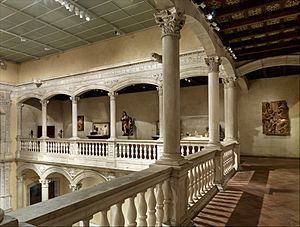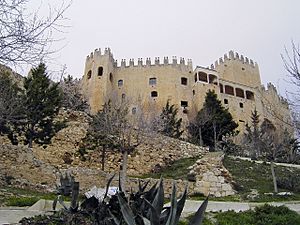Castillo de Vélez-Blanco facts for kids

The Castillo de Vélez-Blanco is an amazing example of a Spanish Renaissance castle. You can find it in the town of Vélez-Blanco, in the province of Almería, which is part of Andalusia, Spain.
Contents
History of the Castle
Building the Castle
This castle was built by Pedro Fajardo y Chacón. He became the first Marquis of Los Vélez after a big war called the Granada War. Construction on the castle began in 1506 and was finished by 1515.
Artists like Jacopo Florentino from Florence and Martín Milanés helped create parts of the castle. Martín Milanés also worked on the Royal Chapel of Granada. The castle was built on the foundations of an older Moorish castle that stood on a hill. Only the old water tank (called a cistern) and some of the original walls were used for the new building.
The work started in an older style called Gothic, but it quickly changed to the new Renaissance style. Even though the outside looks like a strong castle, it was actually designed to be a fancy palace on the inside.
Special Features
One of the most amazing parts of the castle is its central courtyard, known as a patio. This beautiful patio is now kept safe in the Metropolitan Museum of Art in New York City. This patio was so special that it even inspired the design of another nearby castle, the Castillo de La Calahorra. Both patios are considered some of the best early Renaissance examples in Spain.
Today, the castle's main tower, called the Torre del Homenaje (keep), is very impressive. It stands over 65 feet (20 m) tall! This tower was a symbol of the powerful family who owned the castle. Inside, it had wooden stairs that could be removed if there was danger. This would trap enemies and keep the upper part safe. The top of the tower also has many decorative designs.
Later Years and Restoration
Over time, the castle was not well cared for. In 1764, the Marquis of Los Vélez gave a cannon from the castle to a nearby church for its bells. During the Peninsular War, many valuable items from inside the castle were taken. In the 1800s, the beautiful patio was even used to store grain and reeds.
In 1931, the castle was recognized as an important Spanish monument called a Bien de Interés Cultural. It has been restored in different stages since the mid-1900s, including the floors of its towers.
In the early 1900s, the castle's owners sold many of its valuable pieces, mostly to antique dealers in France. Since 1945, the marble patio and the special Spanish wooden ceilings (called artesonados) have been at the Metropolitan Museum of Art in New York. They were given to the museum by a banker named George Blumenthal.
In 2019, researchers found that one of the Spanish ceilings that belonged to Blumenthal is now owned by Mexico. You can see it at the Instituto Cultural Helénico in Mexico City. Also, some decorative carvings from the castle, showing the Labours of Hercules and the Triumphs of Caesar, were found in 1992. They were in the basement of the Musée des Arts Décoratifs in Paris, where they are now on display.
See also
 In Spanish: Castillo de Vélez-Blanco para niños
In Spanish: Castillo de Vélez-Blanco para niños


